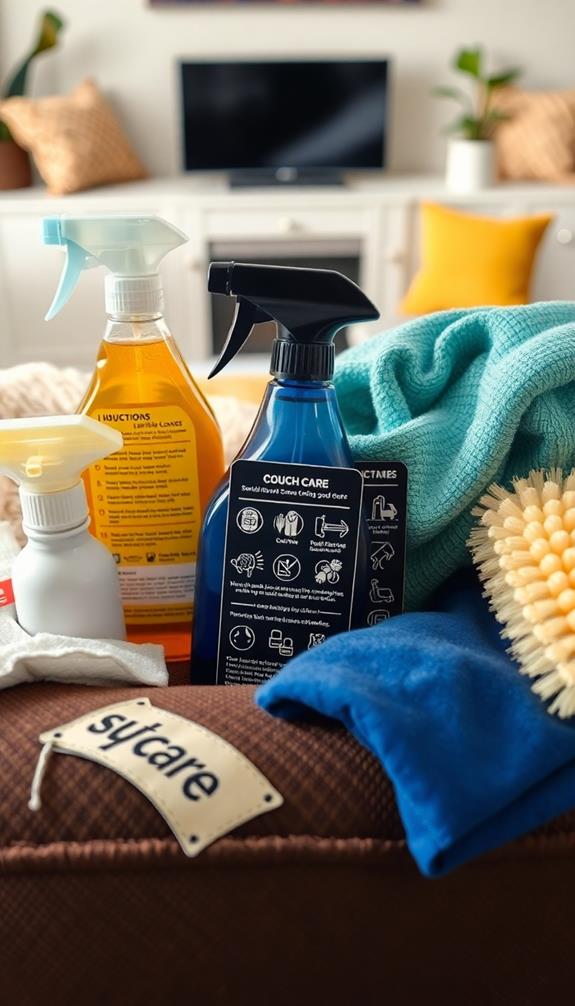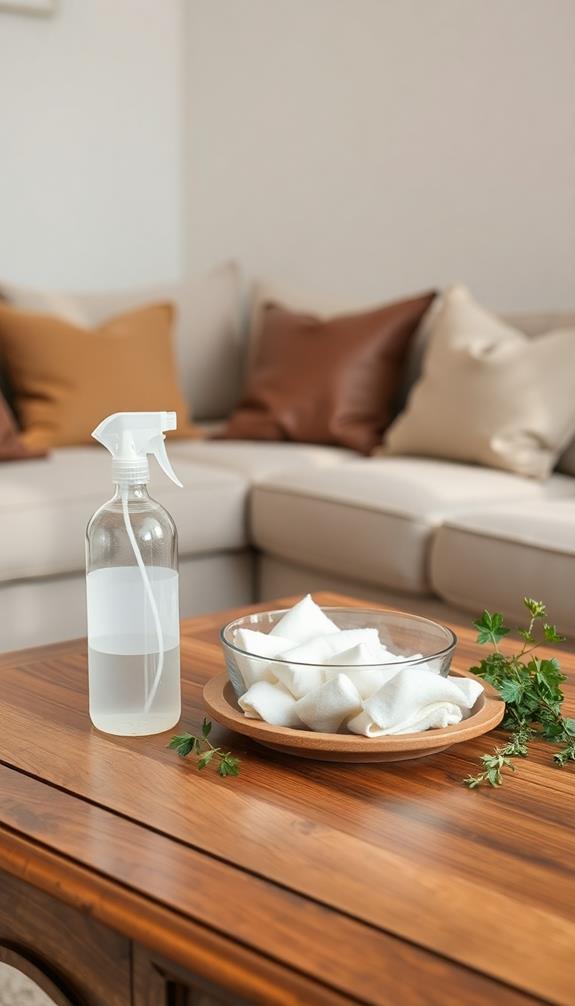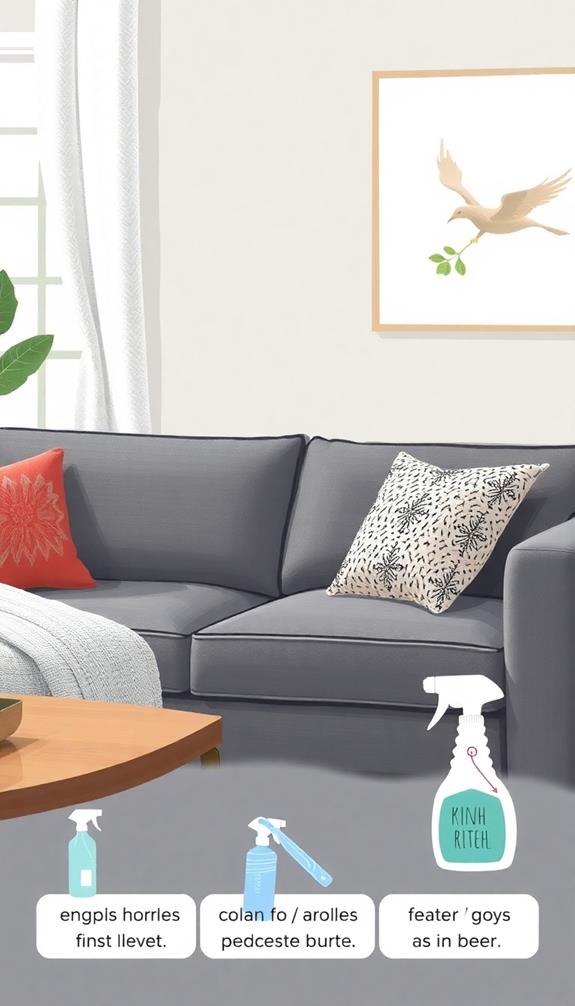To disinfect your couch, start by checking the care tag to avoid damage. Remove cushions and vacuum thoroughly to eliminate dust and allergens. Next, mix a disinfectant solution—like 2 cups rubbing alcohol with 1 cup water—or use equal parts white vinegar and water. Lightly spray the fabric, focusing on seams, then wipe with a microfiber cloth. Allow it to air dry completely. Consider steam cleaning every few months for deeper sanitization. Finally, regular vacuuming and spot cleaning will keep your couch fresh and clean. There's much more to explore about fabric care and techniques if you continue.
Preparation for Disinfection
Before you explore disinfecting your couch, it's vital to prepare properly. Start by checking the care tag for cleaning codes; this will guide you on the best methods to avoid damaging your upholstery. Different fabric types may require specific cleaning solutions, so understanding your couch's material is fundamental for effective cleaning.
Next, gather all the necessary materials, including your vacuum, disinfectant solution, and clean microfiber cloths. For a thorough cleaning, consider using proper identification helps prevent damage when selecting your cleaning products.
Once you have everything ready, it's time to tackle your couch. If your sofa has removable cushions, take them off and set them aside for separate cleaning. This guarantees you can thoroughly clean the entire surface of the couch.
Don't forget to vacuum your sofa; make sure to get into all the crevices and corners to remove dust, dirt, and debris effectively.
Thoroughly cleaning your couch not only prepares it for disinfection but also helps maintain a healthy living space. Regular cleaning reduces the accumulation of dirt and odors, assuring better hygiene overall.
After vacuuming, you'll be primed for the next steps in the disinfection process, knowing you've laid a solid foundation for a fresh and clean couch.
Vacuuming Your Couch
To keep your couch fresh and hygienic, you should vacuum it weekly.
Utilizing a vacuum with an upholstery attachment helps you reach those tricky spots, ensuring you don't miss any hidden dirt or crumbs.
Additionally, regular vacuuming can remove a significant amount of allergens and debris, contributing to a healthier living environment.
Don't forget to pay extra attention to crevices and seams where debris tends to collect, as consistent cleaning helps maintain the appearance of your furniture!
Importance of Regular Vacuuming
Vacuuming your couch regularly plays an essential role in maintaining a clean and healthy living space. By committing to regular vacuuming, you help eliminate dust, dirt, and allergens that can accumulate on your sofa. This not only improves indoor air quality but also reduces respiratory issues, making your home a safer environment.
Aim to vacuum at least once a week to prevent the buildup of dirt and bacteria. Left unchecked, this can lead to unpleasant odors and potential health hazards. Use a vacuum cleaner with an upholstery attachment to thoroughly clean armrests, backrests, and crevices where debris tends to hide. For best results, don't forget to remove the seat and back cushions; this allows you to reach hidden dirt and guarantees all surfaces are cleaned completely.
Moreover, frequent vacuuming enhances the appearance of your couch, keeping it looking fresh and inviting. It also extends the lifespan of your sofa by preventing wear and tear caused by trapped dirt and particles.
Prioritizing regular vacuuming is a simple yet effective way to maintain your couch and promote a healthier living space.
Vacuuming Techniques and Tools
Regular vacuuming sets the foundation for a clean couch, but knowing the right techniques and tools can make a significant difference in effectiveness. Start by using a vacuum cleaner equipped with an upholstery attachment to effectively remove dust, dirt, and debris from all surfaces, including armrests and backrests.
Aim to vacuum your couch at least once a week; this prevents the buildup of allergens and bacteria, promoting a healthier living environment.
When you have removable cushions, take the time to vacuum them separately. This guarantees you reach hidden dirt and achieve a thorough clean.
Don't forget to pay close attention to crevices, seams, and corners, as these areas often trap dust and debris that can affect hygiene.
After you've vacuumed the main surfaces, consider using a soft brush attachment. This gently agitates the fabric, allowing for deeper dirt removal and helping restore your couch's appearance.
Focus on Hidden Areas
Hidden areas of your couch can be a breeding ground for dust, dirt, and allergens. To effectively tackle these hidden areas, start by vacuuming your couch thoroughly. Use the upholstery attachment on your vacuum cleaner to reach those tricky spots, like the armrests and backrest.
Don't overlook the crevices and corners, as they often harbor hidden debris that can accumulate over time. Next, remove the seat and back cushions, and vacuum underneath them. These areas frequently trap dirt and allergens that go unnoticed.
Regular vacuuming is essential; aim to do it weekly to prevent the buildup of bacteria and maintain your couch's longevity. Make sure to vacuum all surfaces, whether they're fabric, leather, or suede.
Different materials might need specific techniques to avoid damage while you clean and disinfect. By focusing on these hidden areas, you can greatly improve the cleanliness and hygiene of your couch, ensuring a healthier living space.
Understanding Care Tags

Understanding Care Tags
Couch care tags are vital for understanding how to properly clean and maintain your furniture. These tags provide essential information about the cleaning methods suitable for various fabric types, helping you disinfect without causing damage.
It's important to know the cleaning techniques specific to your upholstery to guarantee longevity and cleanliness. For instance, cleaning upholstered chairs requires different approaches depending on the fabric type.
Here's a quick guide to interpreting those care tags:
- W: Indicates that you can safely use water-based cleaners. This option allows you to disinfect your couch effectively without harming the fabric.
- WS: Both water and solvent-based cleaners are safe to use. This flexibility lets you choose the best cleaning method depending on the stains or dirt you're tackling.
- S: Only solvent-based cleaning agents should be used here. Water can ruin the fabric, so stick to the recommended products to maintain your couch's integrity.
If you see an X on the care tag, it means vacuuming is your only option—no cleaning products allowed.
Understanding these care tags helps you choose the right cleaning methods, guaranteeing your couch stays clean and lasts for years to come. Always refer to the tag before starting any cleaning process!
Disinfection Methods Overview
When it comes to disinfecting your couch, knowing the right cleaning techniques and effective solutions is key.
Regular maintenance, including weekly vacuuming, can help prevent dirt buildup and enhance the disinfection process.
You can use a variety of methods, from simple soap and water to steam cleaning, depending on your couch's fabric.
Let's explore these options to help you choose the best approach for your needs.
Effective Disinfectant Solutions
Disinfecting your couch effectively requires choosing the right solutions that can tackle germs and bacteria. Here are three effective disinfectant options to evaluate:
- Rubbing Alcohol Solution: Mix 2 cups of rubbing alcohol with 1 cup of water. This solution is particularly helpful during illness and can be sprayed on the couch. Use a clean cloth to wipe it down afterward.
- White Vinegar and Water: For an anti-allergenic option, combine equal parts white vinegar and warm water. Mist this solution onto fabric or leather sofas to eliminate germs. It's a natural disinfectant that's safe for most materials.
- Steam Cleaner: Utilizing a steam cleaner is one of the most effective ways to disinfect your couch. The heat from the steam kills bacteria and germs while also helping to clean a fabric by removing dirt.
Incorporate these solutions into your cleaning routine to keep your couch fresh and sanitized.
Don't forget to follow up with some baking soda to help neutralize odors, ensuring your couch remains a comfortable place to relax!
Cleaning Techniques Overview
Understanding the appropriate cleaning techniques is essential for maintaining a sanitized couch. Start by checking your couch's care tag. If it has a "W," you can use water-based cleaners like soap mixed with water.
For "S" tagged couches, stick to solvent-based solutions, such as a mix of 2 cups rubbing alcohol and 1 cup water, to effectively disinfect.
White vinegar is another excellent option. Mix it with warm water and put it in a spray bottle. Mist this solution onto your couch to eliminate allergens and bacteria, ensuring you don't soak the fabric.
For a deep clean, consider steam cleaning. This method uses heat to penetrate fabric fibers, efficiently eradicating germs and bacteria.
After cleaning, sprinkle baking soda on the couch to absorb any lingering odors. Let it sit for a few hours before vacuuming it away.
Using Soap and Water

A simple yet effective way to disinfect your couch is by using a mixture of dish soap and hot water, especially if your upholstery is labeled with a "W" cleaning code.
This method not only helps clean your fabric but also guarantees a hygienic environment, similar to the non-toxic cleaning solutions recommended for other surfaces.
Here's how to do it:
- Prepare the Solution: Mix a few drops of dish soap with hot water in a spray bottle.
- Apply the Mixture: Lightly spray the soap and water solution onto the couch upholstery, being careful not to oversaturate the fabric.
- Wipe Down: Use a soft cloth or sponge to wipe the fabric clean, working section by section. This guarantees thorough disinfection of the entire surface.
After you've finished cleaning, allow your couch to air dry completely.
This step is essential to prevent any moisture buildup that could lead to mold or mildew.
Regularly using this soap and water method will help maintain your couch's longevity while keeping it clean and disinfected.
Make it a habit, and enjoy a fresher living space!
Rubbing Alcohol Application
Rubbing alcohol is a powerful disinfectant that can effectively sanitize your couch and kill germs. To create your cleaning solution, mix 2 cups of rubbing alcohol with 1 cup of equal parts water in a spray bottle.
Before you apply this solution, always perform a patch test on an inconspicuous area of your couch to check for any adverse reactions. Regular inspection of the couch for early signs of pilling management can also help maintain its appearance while cleaning.
Once you've confirmed there's no damage, hold the spray nozzle about 7 inches away from the fabric. This distance helps you apply the solution evenly without oversaturating the material. Spray from top to bottom, making sure you cover all surfaces, including seams and hidden areas, to maximize the disinfecting effect.
After application, let the couch and cushions air dry completely. This step is essential, as it allows the rubbing alcohol sufficient time to disinfect effectively.
Following these steps guarantees your couch isn't only clean but also free of harmful germs and bacteria. With your couch now sanitized, you can enjoy a fresher and healthier living space.
White Vinegar as Disinfectant

If you're looking for a natural alternative to rubbing alcohol, white vinegar is an excellent disinfectant for your couch. Its acetic acid has antibacterial properties that can kill germs and neutralize odors on various materials, including fabric and leather.
Additionally, using vinegar is a cost-effective way to maintain a clean environment free from harsh chemicals, promoting a healthier home and sustainable cleaning practices.
To get started with cleaning and disinfecting your couch, follow these simple steps:
- Mix your solution: Combine equal parts of white vinegar and water in a spray bottle for easy application.
- Mist and wipe: Lightly mist the solution onto your couch using an aerosol cloth, ensuring even coverage. Then, take a soft cloth and wipe down all surfaces.
- Test first: Always test the vinegar solution on an inconspicuous area of your couch to check for any adverse reactions before applying it widely.
After you've finished disinfecting, allow your couch to air dry completely. This step is essential to prevent moisture damage and to enhance the disinfecting effect.
With white vinegar in your cleaning arsenal, you can effectively keep your couch fresh and germ-free.
Steam Cleaning Your Couch
Steam cleaning your couch offers a powerful way to eliminate germs and refresh your upholstery. This method can effectively disinfect your couch by killing up to 99.9% of bacteria and germs. The process uses hot water vapor at temperatures of 212°F or above, penetrating fabric fibers to loosen dirt and stains.
Before you start, check the care tag on your couch to verify it's safe for steam cleaning, as some fabrics may be sensitive to high heat. For the best results, use a handheld steamer or a steam cleaner with an upholstery attachment to reach all areas, including seams and crevices.
Additionally, proper steam cleaner technique involves using gentle overlapping passes to avoid damage while guaranteeing effective cleaning.
It's recommended to steam clean your couch every 6 to 12 months to maintain ideal hygiene and extend the life of your upholstery. Make sure to have proper ventilation during the process; open windows or use fans to circulate air and help the upholstery dry quicker.
Once you've completed the steam cleaning, allow your couch to air dry fully before using it again. This way, you can enjoy a cleaner, healthier living space while keeping your couch looking its best.
Special Care for Different Fabrics

How can you guarantee your couch stays in top condition while effectively disinfecting it? It's all about understanding the specific fabric your couch is made from. Each type requires a tailored approach to ascertain you don't cause damage while cleaning.
Regular vacuuming is essential to prevent dirt buildup and maintain hygiene, as highlighted in cleaning processes.
Here's how to care for different fabrics:
- Leather: Mix equal parts of water and white vinegar to disinfect your leather couch. Be careful not to oversaturate the material, as excess moisture can lead to damage.
- Suede: For suede, you'll need specialized cleaners. If you notice grease stains, sprinkle talcum powder or corn starch on the spot to absorb the oil. Let it sit before brushing it off.
- Microfiber: If your couch has a "W" on the care tag, you can use a solution of water and dish soap to disinfect a fabric couch. If it's tagged with an "S," treat it with rubbing alcohol instead, using a microfiber cloth for application.
Always check the care tag before cleaning to follow the recommended methods, ascertaining your couch remains fresh and undamaged!
Regular vacuuming also helps maintain hygiene across all fabrics.
Conclusion
Now that you know how to disinfect your couch, think of it like giving your favorite book a good cleaning. Just as dust can obscure the pages and diminish your reading experience, dirt and germs can make your couch less inviting. By following these steps, you're not just revitalizing your furniture; you're creating a cozy haven for relaxation. So grab your supplies and give your couch the care it deserves—after all, it's where countless memories are made!